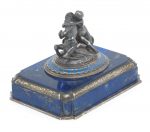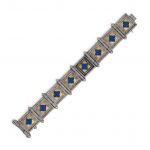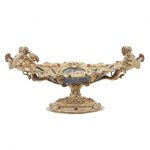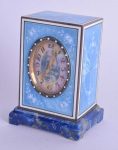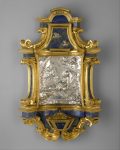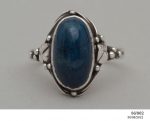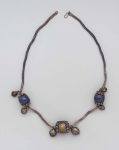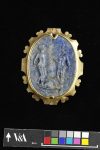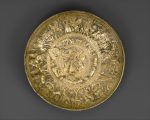Lapis lazuli , or lapis for short, is a deep blue metamorphic rock used as a semi-precious stone that has been prized since antiquity for its intense color. As early as the 7th millennium BCE, lapis lazuli was mined in the Sar-i Sang mines, in Shortugai, and in other mines in Badakhshan province in northeast Afghanistan. Lapis was highly valued by the Indus Valley Civilisation (3300–1900 BC). Lapis beads have been found at Neolithic burials in Mehrgarh, the Caucasus, and even as far from Afghanistan as Mauritania. It was used in the funeral mask of Tutankhamun (1341–1323 BCE). Reference: Wikipedia
A French silver and lapis lazuli paperweight early 20th century, with Paris ‘boar’s head’ mark, maker’s mark unclear The handle formed as a nymph embracing a triton bordered by a blue champlevé enamel mount, on a shaped-rectangular lapis lazuli base, length 10cm.
Sold for £ 875 inc. premium at Bonhams in 2018
Silver pin with lapis lazuli ball head, hole in shank near head.
Reference: © The Trustees of the British Museum
A GOTHIC REVIVAL LAPIS LAZULI, SILVER AND SILVER GILT BRACELET, BY GIULIANO Designed as a series of sculpted silver and silver gilt square-shaped links, each set with a lozenge-shaped lapis lazuli plaque, circa 1875, 7 1/8 ins., in a Giuliano burgundy leather case Signed C.G. for Carlo Giuliano
Sold for USD 10,000 at Christies in 2012
Continental Renaissance Style Gem-Set and Lapis Lazuli Mounted Silver Centerpiece Late 19th century Oval, on a conforming domed foot elaborately repoussé with foliage and grotesque masks, set with cabochon garnets at intervals, the bowl elaborately repoussé with foliage, shells, dragons and strapwork and set with lapis lazuli panels, wth rim set with cabochon garnets at intervals, with lambrequin-form edge, with two griffin-form handles. Height 7 3/4 inches (19.7 cm), width across handles 16 1/2 inches (42 cm).
Sold for $5,625 (includes buyer’s premium)
A FINE CONTINENTAL SILVER ENAMEL AND LAPIS LAZULI CLOCK with unusual painted shell dial. 6 cm x 4 cm.
Sold for £1,300 at Hannam’s Auctioneers Ltd in 2019
Holy-water stoup with relief of Mary of Egypt,ca. 1702 Giovanni Giardini Italian The goldsmith and designer Giovanni Giardini made this object for Pope Clement XI (r. 1700–1712), who presented it to Giovanni Battista Borghese, King Philip V of Spain’s ambassador to the Holy See. Later, it was part of the collection of the Princes of Thurn and Taxis in Sankt Emmeram Castle in Regensburg, Germany. Giardini’s prized devotional objects were intended for private use or for small, intimate chapels. Their technical perfection is such that they outshine many fine works made in Rome during the same period. The combination of the light catching gilded metal and the lapis lazuli with its myriad flecks of sparkling golden pyrites has a mesmerizing effect. Lapis lazuli symbolizes the choir of saints in heaven, and the attention of the person using this stoup would be directed toward heaven, a treasury of everlasting joy. Set around the silver relief of Mary of Egypt in ecstacy, the lapis plaques also suggest that the saint is part of the company of heaven. A related object is preserved in the Schatzkammer, or Treasury, of the Residenz in Munich.
Reference: The Metropolitan Museum of Art
Silver & lapis lazuli ring by Rhoda Wager Made by Wager, Rhoda in Sydney, New South Wales, Australia, c 1927. Sydney jeweller, Rhoda Wager (1875-1953 was born in 1875 in Mile End, London, and studied at Bristol and Glasgow Schools of Art from 1897 to 1903. It was during this period in Glasgow that she trained under the influential metalsmith, Bernard Cuzner, and learned the prevailing Arts and Crafts style. The style is apparent in her jewellery which typically features semi-precious stones set in silver organic ‘vine and leaf’ motif. From 1913 Rhoda spent three years with her brother on his sugar plantation in Fiji and continued her work there.
Reference: Museum of Applied Art and Sciences
Silver chain, 2 large lapis lazuli ornaments, 1 large silver ornament.
Reference: Museum of Fine Arts Boston
Italian, second half 17th century PAIR OF RELIEFS OF THE NATIVITY AND THE ADORATION OF THE MAGI within Baroque style silver- and silvered bronze- mounted and ebonized wood frames embellished with lapis lazuli columns silver, bronze, lapis lazuli and ebonized oak overall 17 1/2 by 13 in.; 44.5 by 33 cm.
Sold for 112,500 USD at Sothebys in 2019
Adam and Eve, cameo in lapis lazuli, Italy, ca. 1580-1600
The art of engraving gemstones has been admired since the early days of the Roman empire. It was revived in Europe during the Renaissance, and again in the 18th and 19th centuries. Cameos and intaglios were prized and collected, sometimes as symbols of power and mounted in jewelled settings, sometimes as small objects for private devotion or enjoyment. Carving in lapis lazuli was fashionable around 1600 in Italy and Bohemia, especially at the imperial court of Rudolf II in Prague.
Reference: © Victoria and Albert Museum
